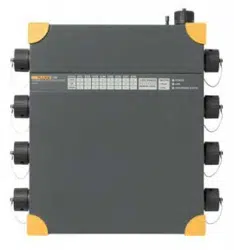Loading ...
Loading ...
Loading ...

Operation
Methods of Measurement/Formulas 3
3-15
where
i
U rms value of the voltage bin with the frequency i⋅5 Hz
i
I rms value of the current bin with the frequency i⋅5 Hz
i
ϕ
phase angle difference between voltage and current of the frequency i⋅5 Hz
The 3-phase real power sum is calculated as
321 LLLsum
PPPP ++=
Apparent power
Apparent power
S is calculated by multiplying rms values of voltage and current of the
given aggregation.
IUS ⋅=
The 3-phase apparent power sum is calculated as
321 LLLsum
SSSS ++=
Reactive power
The harmonic reactive power
h
Q is also derived from the results of the FFT calculations
of voltage and current. The index h in
h
Q indicates that the calculated reactive power
component is derived from the harmonics (FFT) calculation.
∑
=
⋅⋅=
1023
0
sin
i
iiih
IUQ
ϕ
Because every frequency component of the calculation has a sign,
h
Q is also signed. All
other reactive power components are unsigned (always positive) by definition.
The 3-phase harmonic reactive power sum is calculated as
321 LhLhLhsumh
QQQQ ++=
The total reactive power
tot
Q is calculated by
22
PSQ
tot
−=
The 3-phase total reactive power sum is calculated as
321 LtotLtotLtotsumtot
QQQQ ++=
The remaining reactive power component
d
Q (d stands for distortion) contains the rest of
the reactive power phenomena (mainly distortion reactive power and modulation reactive
power, the first originating e.g. from power converters with highly non sinusoidal current
waveforms, the latter from pulsating loads).
1.888.610.7664 sales@GlobalTestSupply.com
Fluke-Direct.com
Loading ...
Loading ...
Loading ...
